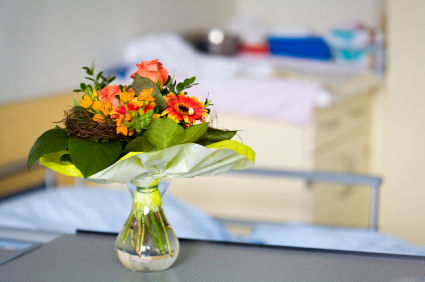![]() Prices in Canadian Dollars.
Prices in Canadian Dollars.![]() Prefer to call and speak to a floral agent? 1-877-277-4787
Prefer to call and speak to a floral agent? 1-877-277-4787
Flowers in Hospital Rooms – Myths & Facts
When it comes to sending a “get well soon” message to a sick acquaintance, flowers are the first and natural choice for many people. They brighten up a dull room, bring some nature into the picture and are just plain good at cheering people up, something that science has proven! Which makes it all the more strange that many individuals still believe flowers should never be placed in a hospital room. Some hospitals even have rules to that effect.

The belief appears to go back a long ways and seems to be somewhat entrenched, in fact the folks at Snopes (an urban-legend website) have traced it back to 1923 in print form, and it most likely spread via word of mouth long before that.
There are a number of myths regarding flowers and poor health. The best known is probably the oxygen-sucking myth, however it is just one of many longstanding beliefs. An old wives’ tale common in England states that if you put red and white flowers in a single vase in a hospital room, a person in the surrounding ward will pass away. Another common legend goes that patients should always leave flower arrangements behind in the hospital room when they’re discharged; if they bring the flowers home, they’ll end up right back in the hospital.
The oxygen-starving myth goes like this: Flowers are bad for hospital rooms because they suck oxygen out of the air. And sick people need their oxygen.
So, what’s the truth about cut-flower arrangements and air composition?
On its face, the oxygen-depletion myth initially seems to make sense to some. After all, most of us were taught in school that plants typically absorb carbon dioxide and emit oxygen and that the process reverses at night. At night, plants absorb more oxygen than they produce, and they emit carbon dioxide.
So, flowers are bad around someone who is ill right?
 Just the opposite! In fact flowers add far more oxygen to a hospital room than they use. In daytime, plants emit 10 times more oxygen than they use up at night, so a hospital room with flowers in it will actually end up more oxygenated than one without. A study published in the journal International Archives of Occupational and Environmental Health in 1977 showed that even at night, plants only altered oxygen and CO2 levels in hospital wards by about 1.5 percent – a negligible amount, in terms of air composition.
Just the opposite! In fact flowers add far more oxygen to a hospital room than they use. In daytime, plants emit 10 times more oxygen than they use up at night, so a hospital room with flowers in it will actually end up more oxygenated than one without. A study published in the journal International Archives of Occupational and Environmental Health in 1977 showed that even at night, plants only altered oxygen and CO2 levels in hospital wards by about 1.5 percent – a negligible amount, in terms of air composition.
It’s especially negligible when you consider that a human being, such as the sick person lying in the bed in the hospital room, uses up about 2.5 cubic feet (71 liters) of oxygen in an hour, while a pound of flowers & foliage (a substantial amount) sucks up only about 0.1 liters in oxygen in that same time period. If a patient being exposed to “oxygen-starvation” were a concern it would make far more sense to ban oxygen-sucking visitors than to ban flowers!
So why would a hospital ban flowers from intensive care units? Some people think the myth is simply so pervasive, hospitals have incorporated it in their policies. More likely it is due to the fact that most health care systems in today’s world are simply overburdened and flowers are potentially one more task for busy staff to deal with.
On the very positive side at least one study has shown that having flowers in a hospital room makes patients feel better. A 2008 study in the journal of the American Society for Horticultural Science revealed that patients in hospital rooms containing flowers or potted plants used less pain medication and had lower blood pressure than patients in rooms without them.

